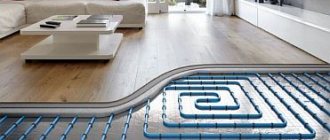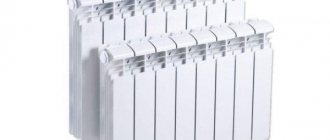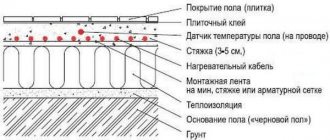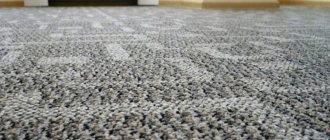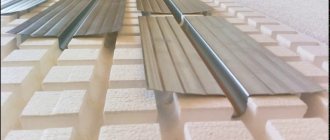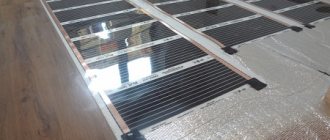Types of electric skirting boards
The issue of cost is one of the main ones that worries buyers of electric baseboard convectors not only in Moscow. Their prices largely depend on the type of construction. Today, baseboard convectors are available in two versions:
- Electric. It uses dry heating elements installed in copper tubes. This design provides more efficient and safe heating of the room. To connect such a system, you will have to lay powerful electrical wiring into the room. If necessary, you can achieve a more economical operating mode by additionally installing a thermostat.
- Water. The main working element is the heating boiler. According to the principle of operation, such a system is very similar to a standard scheme with radiators.
Systems of this type can be used as the main heating device.
The water system includes the following elements:
- a radiator made in the form of a box with a heat exchanger located inside it;
- a distribution manifold in which two lines are installed to ensure the supply and return of coolant;
- set of plastic tubes. They are installed in such a way that a part with a smaller diameter is located in a wider one.
Installation of a warm water baseboard system
Warm floors through heating.
Water heated floor as the main heating Installation of an electric heated baseboard is very simple: we fix it on the wall. That's it, the system is ready for use. All that remains is to plug it into the sockets. The main thing is that the cross-section of the wire is correctly calculated and that there are circuit breakers of the correct rating. This is the main problem when using an electric warm baseboard. The water one is much more difficult to install. Everything must be collected into a single system, and this is not easy.
Installation of a heating baseboard: you need to know the nuances
Calculation of baseboard heating
A complete thermotechnical calculation of heating is a long and complex matter.
The size and geometry of the room, the material of the walls, floor, and ceiling are taken into account, and the degree of insulation of all structural elements, including windows and doors, is taken into account. In general, the calculation is not easy at all.
Therefore, most often they take the average figure, which is derived as a result of the analysis of many calculations.
It is believed that to heat one square meter of room area with average insulation, 100 W of thermal energy is needed. That is, to calculate the power of a warm baseboard, you need to multiply the area of the room by 100. Get the required figure. This is exactly how much (or better, about 20-25% more) should be given in total by all the elements of the warm baseboard.
An example of the technical characteristics of the Best Board warm baseboard for different operating modes of the system
For example, the area of a room is 18 square meters. To heat it you will need 1800 W. Next, we look at how much heat is generated by one meter of heating. A water heating baseboard can operate in different modes; depending on the mode, it emits different amounts of heat. The table above shows data for one of the systems. For example, let's take the heat transfer of one meter of warm baseboard from this table (other manufacturers may have significant differences).
For example, the system will operate with a supply temperature of 50°C. Then one linear meter produces 132 W of heat. To heat this room you will need 1800/132 = 13.6 m of warm baseboard. When ordering, it is better to add a margin of 20-25%. This reserve is necessary so that the system does not work at the limit all the time. This time. And also in case of abnormal cold weather. That's two. So, we take 17 meters with a reserve.
Once again, please note: these are average data for some average house. Moreover, even the height of the ceilings is not taken into account. Again, it is taken as average - 2.5 meters. If your insulation is better, you will need less heat; if it is worse than “average,” you will need more. In general, this method provides only approximate calculations.
How to act
The first thing to do is to draw a plan on which to indicate the length of each heating device and the length of the connecting pipes. After all, the length of a warm baseboard is not always equal to the perimeter of the room. In this case, the sections of heating devices are connected to each other by copper or polymer pipes. It is undesirable to use steel ones, since they chemically interact with copper (it gradually collapses).
Preparation for installation occurs long before its actual start. At the very beginning of the repair, even before leveling the floor, pipes are stretched from the boiler or collector unit to the connection point for the warm baseboard. The pipes are laid, tested for integrity, filled with screed under pressure (working pressure in a private house is 2-3 atm, in a multi-storey house you need to find out from the housing office). Then all repair work is carried out and only after the walls and floor are finished, the installation of warm baseboards begins. Here's the order:
- Heat-reflecting tape is attached along the perimeter of the walls.
It prevents heat loss to heat the wall. Thermal insulation tape is attached, and fasteners are placed on top of it - Fastening elements are installed on top of the tape in increments of 50-60 cm. They are fixed to the wall using dowels or self-tapping screws (depending on the wall material).
- According to the plan, sections of the heating baseboard are fixed in the fastening elements and connected to each other with copper or polymer pipes.
We install the pieces and connect them into a single whole - The tightness of the system is checked using pressure testing.
- If everything is normal, pipes from the collector unit or from the boiler are connected, the system is filled with coolant and tested.
This is what it looks like when it's done - After successful tests, decorative covers are installed and the baseboard heating system is ready for operation.
Actually, installing warm baseboards is not too complicated. But the tightness of the connections is important and special attention must be paid to this.
Heat plinth: design features
It became possible to buy a warm baseboard not so long ago. In fact, this system was designed with the aim of increasing heating efficiency while using less energy. Moreover, such panels look very original, and warm baseboard technology often allows you to completely abandon the use of traditional heating methods using radiators.
Externally, the heating panel looks like an ordinary floor plinth
Externally, the heat plinth is a strip made of aluminum that covers the internal contents of the box. If it were not for its very modest dimensions, one could call it a full-fledged heating device, however, the fact that the box has a low height, does not protrude much from the wall and is mounted along the perimeter of the room on the wall near the floor gives it the right to be called a plinth.
Inside the box there is a heating system, which may differ depending on the type of baseboard chosen. You can understand what the difference is by considering the existing types of warm baseboards.
The principle of operation of baseboard heat as a heating device
Obviously, this heating device got its name due to its location. The warm baseboard is attached in the same place as a regular one - around the perimeter of the room. The main advantage of such a heating system is that the device heats not only the air around it, but also the walls with which it comes into contact. This system allows for better heat retention and reduced heat loss.
The fact that air convection is reduced and the heat is evenly distributed throughout the room, without concentrating in one place, as is often the case with traditional radiators, also has a positive effect. A significant advantage is that due to the slow movement of air from the baseboard to the ceiling, dust practically does not rise from the floor. And this not only makes cleaning much easier, but also has a positive effect on the health of residents.
An electric warm baseboard was used to heat the room.
The temperature limits within which the device operates are 40-70 degrees and using a thermostat you can set the indicator within these limits. According to reviews from the owners, a warm baseboard never allows the air temperature to drop below 20 degrees, and this can be considered a completely comfortable temperature for living. Of course, this applies to cases where the calculations of the required number of elements and their power were carried out correctly.
If we are talking about installing an electric baseboard, then it is also worth noting the fact that, like one section of any traditional radiator, one segment of a warm baseboard emits 190 W of heat. At the same time, the energy consumption for its production is 3 times less, and this is a considerable saving for the entire heating season.
As a heating device, a warm baseboard can be installed in almost any room. Neither the size nor any location of the room can serve as a contraindication to its installation. It is generally accepted that this design option is ideal for rooms with panoramic glazing, where ordinary radiators under the windows simply will not fit.
Warm baseboard is an ideal solution for installation in a room with panoramic windows
Helpful advice! Warm baseboard is an ideal solution for rooms with high ceilings, where an additional or main source of heating is required. The main thing is to take care of the proper power of the device.
The design and principle of operation of a warm baseboard
How to make air heating of a private house with your own hands
A warm baseboard is a fairly simple device, consisting of an electrical module and a natural shell that does not emit foreign odors when heated.
Electric baseboard diagram
What is a warm baseboard? In general, there is no new word of technology in this device. Just the same principles of electric heating, only in a new design.
Inside the device there are heat exchangers mounted on copper tubes. The whole peculiarity of this device is its compactness. The entire structure fits into a narrow box about fourteen centimeters high and three centimeters wide. Such heaters are installed around the perimeter of the room and can serve as the main and additional means of heating.
Electric baseboard installation
Heated baseboard design:
- tube convector;
- a box with fasteners for attaching heating elements;
- rotating parts.
All these parts of the device are easily assembled into one whole and their installation does not create any problems. The principle of heating a room using this design is also primitive. A heat flow is created along all the walls, which prevents the cold from penetrating into the room. The walls become warm and release thermal energy to the air in the room.
The principle of heating with a baseboard system
Baseboard heating
Do-it-yourself heating from polypropylene pipes in a private house
Despite the fact that in our country what a warm baseboard is became known not so long ago, in Europe premises have been heated using this method for several decades. This technology is very simple, but at the same time quite convenient. The basis is metal (most often copper) pipes, which are also the heating element. The pipes are installed in the same place where the baseboard usually runs, that is, along the perimeter of the room. Then they are covered with a metal box made of plates with a corrugated surface. Due to this design, the box acts as a heat exchanger, thereby increasing the efficiency of the structure.
In general, a water baseboard consists of the following elements:
- front panel with holes that ensure air flow (standard size: width - 3-4 cm, height - 15-20 cm);
- rear panel - facilitates installation of the structure and protects the wall from constant exposure to high temperatures;
- heating radiator that performs the heating function (standard dimensions - 1 m x 0.4 m x 1.6 m);
- rotating side plugs;
- a heat exchange module consisting of two tubes through which water circulates.
Currently, there is a variety of warm baseboards (electric.) They differ from warm water baseboards only in the type of heating element.
Due to the fact that the baseboard is installed around the perimeter of the entire room, the heat gradually rises, and then the entire room is evenly heated. As a result, this technology does not cause temperature changes. Since the heating element is hidden under the front panel, it is not noticeable, which distinguishes it from massive ones. As you can see in the photo, the warm baseboard looks very neat; it can be additionally decorated so that it better matches the overall style of the room. The system is effective, but at the same time quite simple to install. Having minimal skills, you can carry out installation without involving professionals.
Purely masculine and purely feminine
Installing a warm baseboard
“I installed both floors and skirting boards - I can say that the heating quality of the skirting board is better, and the price is cheaper,” comment from an installer from the Rmnt forum.
And a very feminine one on ForumHouse: “In my opinion, this is an excellent solution for electric heating... I found several manufacturers on the Internet. Domestic ones are not expensive, but somehow they don’t look presentable. Imported ones are beautiful, but more expensive,” - that’s why they are imported, so that they are both more beautiful and more expensive!
How to make a warm baseboard with your own hands
Even if made in Russia, this pleasure is not cheap. But what if you want to try such a system, but don’t have a lot of “extra” money? Do it yourself. There are two working options.
Option one
Used with a diameter of 12 mm, sheets of roofing copper 0.4 mm thick. The order of work is as follows:
- Cut a strip of roofing copper (60 cm) with a grinder into strips of 15 cm.
- The edges of the full length strips should be beaded at an angle of 90o and the flange length is 7-8 mm. The length of the strips is no more than 3 meters - it is inconvenient to work with large pieces.
- Solder copper tubes to the back side of this plinth. To do this you need solder (plumbing solder containing 3% copper) and a torch. When soldering, point the torch at the tube: the strip is thin and will warp if overheated. The tube can withstand heat normally.
- Bend the ends of the tube slightly before soldering. This will make it more convenient to put adapters on them.
- For assembly, oil and petrol resistant hoses were used that can withstand working with coolant up to 120 oC (internal diameter 12 mm). At the connection points with the pipe they were secured with ordinary clamps.
- To regulate the temperature, a manually adjustable thermostat is installed.
- The joints are covered with similar inserts/plinths made of copper, but without pipes.
- The panels are attached directly to the wall using standard mounting clips (by the pipes). Do not insert them into the recesses - most of the heat is lost.
This system has worked in a wooden house for 9 years. There were no problems or need for repairs. The coolant temperature at the inlet is from 50 oC to 70 oC. In a room, 20-21 oC when rising is too hot.
Second option
In this case, aluminum profiles for working with drywall were used to make a warm baseboard with your own hands. Holes are cut (sawed) in them with a grinder at the top and bottom, after which they are attached to the walls. Two copper pipes are laid on a thin aluminum ceiling profile, screwed with aluminum wire. This entire structure is laid inside and fixed to the wall so that the pipes are one above the other. The pieces of such a homemade plinth were assembled by welding with copper pipes and fittings. “Front panel” is the same profile, only painted with radiator paint to match the walls (floor). This homemade warm baseboard is less effective and more difficult to clean, but it is also very functional.
Types of heating baseboards
The baseboard heating system can be of two types: with electric and water heaters. At the installation stage, a system with warm water baseboards is more complicated (a collector or radial connection is required), but during operation it is more economical. An electric warm baseboard can be installed quickly - you just need to fasten the heaters to the wall, and immediately after installation it is ready for use. But heating costs, like any electric heating, are high.
One of the most inconspicuous heating systems is a warm (heating) baseboard
Heating device with warm water baseboard
The water baseboard heating system differs only in the non-standard shape of the heating devices. The key components do not differ from the standard ones: you need a hot water boiler, a collector unit and a pipe system with which the warm baseboard is connected.
There is also a combined warm baseboard - with an electric heating element and pipes for coolant
Please note: the optimal operating mode of the system is low temperature. Supply 40-50°C, return about 5°C lower
Therefore, you need to select a boiler or build a system based on this. If the boiler is gas, the best choice is a condensing boiler. When installing any other, the system requires a heat accumulator and/or a mixing unit to reduce and stabilize the temperature.
Connection method
There are also features in choosing the connection method. Connecting all baseboard heaters in series in a room is ineffective: by the time the coolant reaches the last ones in the heater branch, it will cool down greatly and they will remain cold almost all the time.
The radial connection diagram looks something like this
For a water heating baseboard, a radial system is used: devices are connected one at a time or in pairs. To do this, a collector unit is built into the system, to which the pipes that go to the heating devices are connected. The disadvantage of such a system is the high consumption of pipes. After all, each device (or small group) has two pipes - supply and return. The pipe flow rate is much higher, but the heat distribution is more uniform and the system itself is more reliable. Why is it more reliable? If pipes or radiators in one group are damaged, all others work normally.
Installation features
When installing water baseboard heating, the pipes are usually hidden in the floor. It will not be possible to lay them along the walls, since the space is occupied by heating devices. That is, installation of warm water baseboards is possible only at the renovation stage - the floors will have to be raised.
Very attractive when assembled
It is recommended to lay special polymer pipes in the screed - they are not subject to corrosion and have low heat transfer, that is, heat loss during transportation of the coolant will be small. But since these systems have limited availability for repairs, you need to buy high-quality products from well-known manufacturers, and this is not cheap.
Electric warm baseboard
An electric heated baseboard differs in appearance from a water baseboard only in the presence of terminals for connecting power. Otherwise the view is the same. These are two tubes with perpendicularly fixed aluminum/brass/copper plates. In the lower tube there is a heating element - heating element, in the upper tube there are wires for connection.
General design of a heating baseboard
Installing and connecting an electric heated baseboard is much easier. You just need to secure it, stretch the wires and connect them to the terminals. To maintain the set temperature, a thermostat is built into the system, which turns the heaters on and off. The use of thermostats is desirable, as it optimizes operation and saves electricity.
Installation is really simple, but you need to connect the electric warm baseboard to a dedicated line with a correctly selected circuit breaker rating and single-core copper wires of the appropriate cross-section. So in this case, repairs are required - it is customary to lay the wiring in the wall, and for this you need to do it, that is, break the walls.
Scope of application, prices, manufacturers
You can install a baseboard heater in any room for any purpose. There are special models for high humidity conditions. From a design point of view, they are almost ideal: they do not spoil the interior and do not attract attention. It feels very comfortable to be in such a room: the air is fresh and there are no foreign odors.
There is only one feature: they are effective in homes with permanent residence. At a minimum, with constant heating at low temperatures and periodic increase to a comfortable level. The fast heating mode is not their area of application: the power is low. Requires long heating time.
There are both European and domestic manufacturers on the market. With prices and quality as usual: Europeans have beautiful, reliable, expensive; Domestic ones are cheaper, but worse made. And the difference is not only in appearance. This is often more or less normal. The problem is the occurrence of creaks and clicks in the system during sudden heating and cooling. This problem is typical for the connection of two metals: different temperature expansion provokes the occurrence of this effect. Europeans have been producing such equipment for decades and have learned to deal with it. Ours don’t know how yet. So this is the feature. Based on this, whenever possible, install warm baseboards from trusted and venerable manufacturers in your bedrooms.
There are models with copper plates. They have very high heat transfer and corresponding prices
By names and countries of manufacturers something like this:
- Chemo Thermboard - Austria
- Best Board Austria
- Termaskert - England
- Thermia - Ukraine
- Aurora - Ukraine
- Mr. Tectum - Russia
- KZTO - Russia
Operating principle and differences
Manufacturers of baseboard heating claim that the system is more economical than all other types of heating. Savings are 20-30%. This happens because lower temperatures are required to achieve a comfortable feeling. This is because most of the heat is transferred by radiation rather than by convection.
Almost all existing heating systems do not create the best thermal picture: warm air accumulates at the top, while cold air remains at the bottom. If the room does not have very high ceilings, the situation is tolerable, but in rooms with large heights this is critical. To equalize the temperature picture, forced convection is used: fans are built into heating devices that more or less effectively mix the air masses. But active air movement carries dust and germs. At the same time, stagnant zones still remain in the corners of the rooms, in which cold air accumulates.
When using baseboard heating there is no thermal cushion at the top, the air is fresh and the feeling is comfortable
Uneven temperatures and dust in the air are not all the troubles of convection heating. There is also dampness that appears on the walls. The fact is that convection heats the air. The walls remain cold. When warm air comes into contact with cold walls, condensation occurs, the walls become wet, and fungi and mold develop. Moreover, this picture is typical for houses and apartments with good insulation.
Baseboard heating works differently
The first important difference: the lower layers of air immediately heat up, which is already comfortable. Gradually and slowly rising up along the walls, the air cools, transferring heat to the walls
Therefore, it turns out that the top is not warmer (or not much warmer) than the bottom.
Only about 20-30% of the heat is spent on heating the air by convection. Everything else goes to heating the walls. And this is the second important difference. The heated air rises along the walls, rather than mixing with the rest (this effect was noticed by the scientist Coand). Therefore, the rising warm flow cuts off the cold from the walls and heats them. Yes, while the walls heat up and dry out, a lot of energy (and fuel) is consumed. But after that the entire surface begins to radiate heat.
This is where the savings zone begins: a person feels comfortable if the wall temperature is 36-37oC and the air temperature is 16oC. We simply feel the heat emanating from the walls with the entire surface of the body. At the same time, the cost of maintaining the temperature of dry walls is low. After all, it is the water contained in the materials that is the best conductor of heat, and the air that replaces it, on the contrary, conducts heat poorly.
This is what one of the options looks like up close
That is why with such heating it is not so important whether there are pieces of furniture along the walls or not: it is mainly the walls that are heated, not the air. Let them take away some of the heat, but then they themselves will begin to give it back. But the walls will heat up anyway.
Is there enough power?
The design of the baseboard heater provides protection against overheating
Comparing the dimensions of steam heating batteries with the miniature dimensions of baseboard heaters, the authors of reviews of infrared baseboard heaters ask the question: will they heat?
Craftsmen are found, they make calculations, and they get a figure that says that in order to maintain normal temperature in the room, the baseboard heater located around the entire perimeter of the room must heat up to 50°C.
It's a lot. You might get burned. And the furniture standing nearby will warp.
Baseboard heater Megador
However, reviews of baseboard heaters indicate that they regularly maintain a comfortable temperature even in winter and do not create any inconvenience. Particularly noteworthy are the positive reviews of Megador baseboard heaters: they take up little space, consume little energy and, most importantly, can work around the clock.
“I heated the stove during the day, turned on the warm baseboard at night - and the temperature in the house does not drop below 20°,” comments a certain villager (or the village owner of a country cottage) on ForumHouse.
Although, of course, for most of our contemporaries 20°C around the clock will not be enough...
Is the price per meter justified for installing a warm water baseboard?
The data from this table will be useful for calculations.
| product name | Unit | Price per m.p./piece, rub. |
| A heating element | m.p. | 2010 – 2120 |
| Front Panel | m.p. | 670 – 720 |
| Top mounting strip | m.p. | 360 – 400 |
| Bottom mounting strip | m.p. | 190 – 230 |
| Bracket for mounting the heater | PC. | 70 – 90 |
| Inner corner cap | PC. | 70 – 90 |
| External corner cap | PC. | 50 – 60 |
| End cap | PC. | 100 – 120 |
| Fitting for straight sections | PC. | 170 – 200 |
| Flexible tube with seals for 90° and 180° rotation | PC. | 415 – 440 |
To analyze the parameters of a warm water baseboard, the price and reviews should be studied together. The approximate cost of one linear meter of the system is 3,600 rubles. To equip a room of 20 sq. m. when installing a plinth along only two walls, you will need to spend 32,400 rubles. The price of standard aluminum radiators for such a room, together with Mayevsky taps and regulators, is about 8,500 rubles. According to construction forums, ordinary users do not experience significant installation difficulties in both cases.
When painting the outer surface of a water heating baseboard in a certain color to better match the interior, you will have to pay from 900 to 1,400 rubles. for 1 m.p.
Advantages and disadvantages of warm skirting boards
Next, we will consider the pros and cons of warm baseboards, both water and electric. Let's start with the positive features:
Skirting radiators are an excellent choice for rooms with panoramic windows.
- The miniature size of the equipment is perhaps the most important advantage characteristic of any warm baseboards, including electric ones. Thanks to this, we have the opportunity to have at our disposal an extremely compact heating system that is not conspicuous;
- Possibility of heating rooms with panoramic windows - warm baseboards will provide reliable protection from cold air flows and prevent the formation of condensation;
- Low temperature of the housings - as a rule, it does not exceed +40 degrees, so accidental touching the baseboard radiators does not lead to burns;
- Uniform heating of air masses throughout the entire volume - you will not feel discomfort or cold feet;
- Warm skirting boards (including electric ones) are suitable for use in any premises - kitchens, living rooms, bedrooms, corridors, loggias, covered balconies, terraces, retail premises, entrances, halls and much more;
- Possibility of simultaneous operation with any other heating devices. For example, electric convectors can be used together with electric warm baseboards, and classic batteries are often installed together with water appliances.
There are also some disadvantages:
There are some difficulties when installing warm baseboards in a room with built-in furniture.
- The high cost of warm baseboards is typical for any equipment, including electrical equipment;
- Lack of efficiency - many manufacturers claim that baseboard heating allows you to save money, but these claims can be questioned;
- High energy consumption is typical for electric models. Even if your area has rural rates, the costs will be very high;
- It is impossible to lay warm baseboards where built-in furniture is installed - it covers the space necessary for installing equipment.
However, baseboard heating continues to grow in popularity. Where just recently there were bulky cast iron radiators, today extremely compact warm baseboards are appearing - electric and water. Thanks to their thoughtful design, they provide quick and uniform heating of rooms, giving people warmth.
Conclusion
The choice depends on financial capabilities and the specifics of the premises. Since warm baseboards appeared relatively recently, they have not yet been thoroughly studied by consumers, so people often choose the “warm floor” system.
average rating 0
more than 0 ratings
Share link
Comments
Olga 01/15/2019 07:46
Hello. Are there any contraindications to installing a warm electric baseboard for any type of floor (parquet, laminate, etc.) Thank you in advance for your answer. Olga
Choosing a baseboard infrared heater
In order not to make a mistake when choosing an electric baseboard convector, you first need to get acquainted with the existing varieties. The most in demand both in Moscow and in other cities are infrared devices. Such designs have an operating power of no more than 150 W. They can be used as the main heating method, since they are able to generate 5 times more heat than similar devices.
The design of such a system includes anodized aluminum lamellas, which ensure strong heating of the walls and nearby surfaces. By installing such skirting boards, an effective curtain is created that perfectly protects the room from cold air.
Cable heater device
Skirting boards of this type can be used to heat any premises, except those where high humidity prevails. The advantage of these heating systems is a more simplified assembly scheme. The heating elements are mounted in a box; there is no need to install a manifold or lay supply lines.
Operating principle of a plinth convector
During operation of heating baseboards, maintaining a comfortable temperature in the room is ensured not only by influencing the air in the lower part of the room, but also by transferring heat to the wall surfaces. In order to heat the air by convection, you have to spend about 30% of the total energy, and the rest of it goes to warming the walls.
After the air warms up to the required temperature, it begins to rise up along the walls, where it mixes with warmer air currents. As a result, an air cushion appears. After the walls warm up to a temperature of 37 degrees, they begin to release the resulting heat into the room.
When choosing the best option for a warm baseboard, you need to pay attention to its price. The cost of such a system may vary
Much depends on the features of the device and the characteristics of a particular model. The design of the baseboards has a heating element, which is covered with a light metal strip. This element includes copper tubes to which the radiator plates are connected.
Installation Features
effectively
Installation of warm Megador plinth is carried out in two stages. It all starts with preparing the terminals for connecting the structure, then the supply lines are laid and the cable is connected.
The second stage begins only after finishing the room. When using a water-type heating baseboard, all its elements are first installed, modules are connected to the output elements, after which the circuits are adjusted and the system is pressure tested. In the case of an electric warm baseboard, you first need to install all the elements of the housing, connect them to the circuit terminals, and then take insulation measurements. At the final stage, the thermostat is adjusted.
Particular attention should be paid to calculating the number of sections where it is important to avoid mistakes. Here you need to pay attention to the power of the system and possible heat loss
The final results will differ in each case. It all depends on the quality of thermal insulation of walls, window structures and air temperature. I would like to draw your attention to the fact that when using electric type skirting boards on an area of 10 m2, 0.5 kW will be required. If the water option was chosen, then this figure is doubled.


